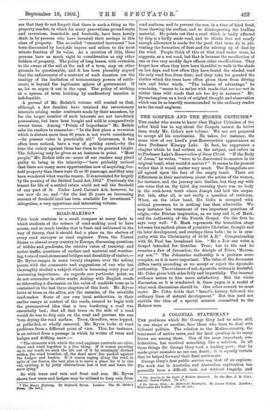ROAD-MAKING.* Tins book contains in a small compass- so many
facts to which students of the science of road-making need to have' access, and so much besides that is fresh and unbiassed in the way of theory, that it should find a place on the shelves of every road surveyor or road engineer. From "the United States to almost every country in Europe, discussing questions of widths and gradients, the relative value of tramway and motor traffic, questions of surface and material and weather- ing, tests of road-stones and bridges and durability of timber,— Mr. Ryves ranges in some twenty chapters over the salient points with the comments and suggestions of one who has thoroughly studied a subject which is becoming every year of increasing importance. As regards one particular point, we do not remember in other works dealing with English roads so interesting a discussion on the value of roadside trees as is contained in the last three chapters of this book. Mr. Ryves looks at trees as the allies, not the enemies, of the scientific: road-maker. Some of our own local authorities, in their earlier essays at control of the roads, seemed to begin with the preconceived idea that a tree bordering a road was essentially bad ; that all that trees on the side • of a road would do was to drip rain on the road and prevent the sun 'Tom drying the road surface. Trees, therefore, were lopped, or pollarded, or wholly removed. Mr. Ryves looks at road problems from a different point of view. This, for instance, is an extract from a passage in which he writes of trees and hedges and drifting snow "The elements with which the road engineer contends are alive Snow and wind together is a live thing. If it comes prowling on to our roads we suck the life out of it by cunningly de eddies, the wind breathes off, the dead snow lies packed against the hedges and .bushes. If it comes raging along the road, in spite of our fences, the best plan is to leave a place for it to run out, exciting. it by pbtty obstructions lest it rest and leave the snow lying."
So with trees and rain and frost and sun. Mr..Ryves shows how trees and hedges may be utilised to keep rain from • The King's Highway. By Reginald, Byres. London The fit. Bride's Press. rbs. net.] road surfaces, And to prevent the' sun, in a time of hard front, • from thawing the surface, and so disintegrating the binding material. He points out that a road which is badly affected by drip is a badly made road, and he thinks that not neally enough allowance is made for the good that trees do in pie- venting the formation of dust and the stirring up of dust by • the wind. People think of this or that road under trees, he suggests, as a wet road, but that is because the recollection of one or two very muddy days effaces other recollections. They forget how often they have been thanleful to walk in the shade on hot days, and how often they have found the shaded road the only road free from dust; and they take for granted the shelter which the trees have 'often given them from driving rain and bitter winds. "The balance of advantage," -he concludes, "seems to be rather with roads that are too wet in winter than with roads that are too dry in summer." Mt. Ryves has given us a. book of original thought and observation which can be as heartily recommended to the ordinary reader as to the road engineer.










































 Previous page
Previous page